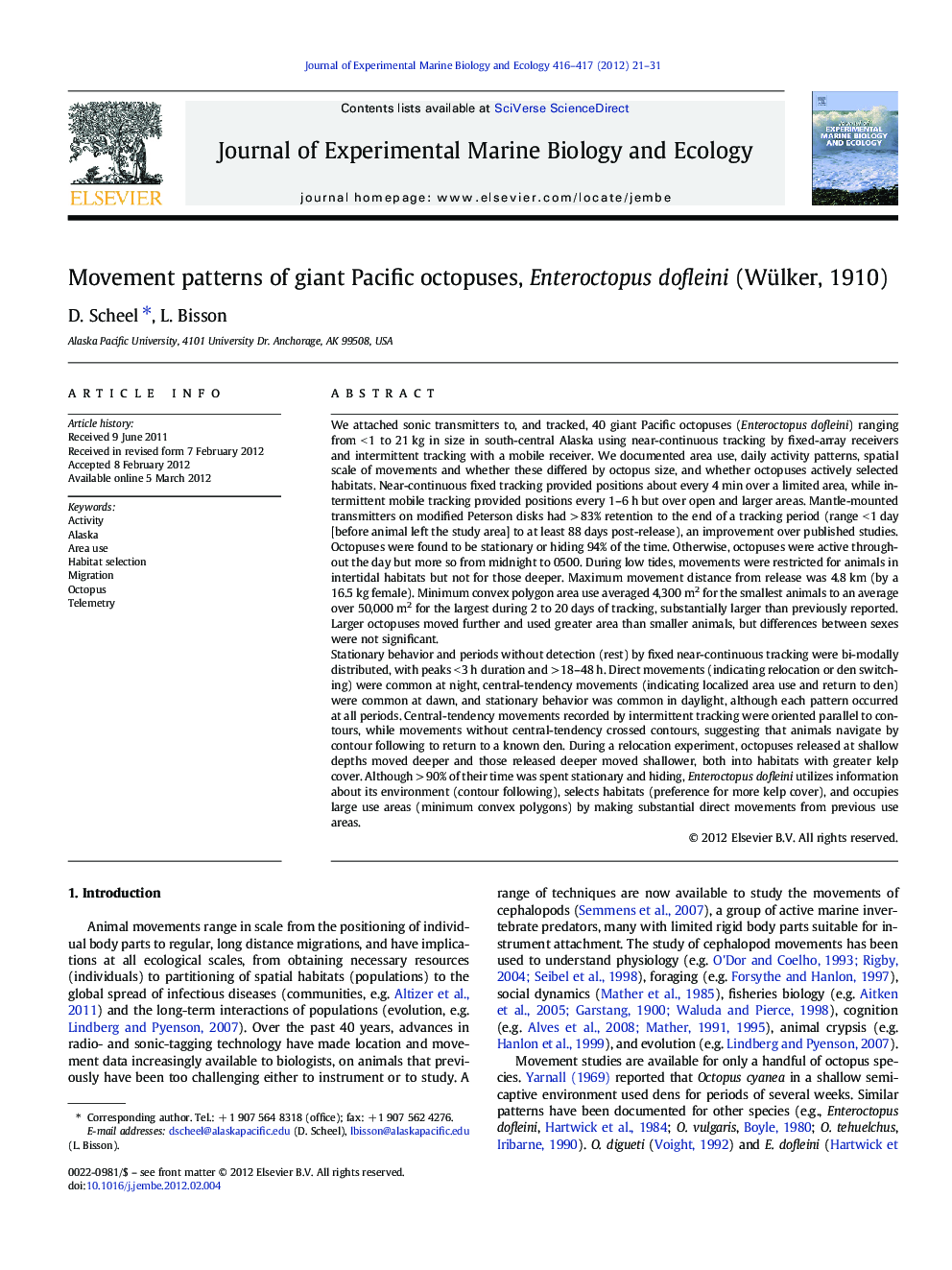| کد مقاله | کد نشریه | سال انتشار | مقاله انگلیسی | نسخه تمام متن |
|---|---|---|---|---|
| 4396088 | 1618449 | 2012 | 11 صفحه PDF | دانلود رایگان |

We attached sonic transmitters to, and tracked, 40 giant Pacific octopuses (Enteroctopus dofleini) ranging from < 1 to 21 kg in size in south-central Alaska using near-continuous tracking by fixed-array receivers and intermittent tracking with a mobile receiver. We documented area use, daily activity patterns, spatial scale of movements and whether these differed by octopus size, and whether octopuses actively selected habitats. Near-continuous fixed tracking provided positions about every 4 min over a limited area, while intermittent mobile tracking provided positions every 1–6 h but over open and larger areas. Mantle-mounted transmitters on modified Peterson disks had > 83% retention to the end of a tracking period (range < 1 day [before animal left the study area] to at least 88 days post-release), an improvement over published studies. Octopuses were found to be stationary or hiding 94% of the time. Otherwise, octopuses were active throughout the day but more so from midnight to 0500. During low tides, movements were restricted for animals in intertidal habitats but not for those deeper. Maximum movement distance from release was 4.8 km (by a 16.5 kg female). Minimum convex polygon area use averaged 4,300 m2 for the smallest animals to an average over 50,000 m2 for the largest during 2 to 20 days of tracking, substantially larger than previously reported. Larger octopuses moved further and used greater area than smaller animals, but differences between sexes were not significant.Stationary behavior and periods without detection (rest) by fixed near-continuous tracking were bi-modally distributed, with peaks < 3 h duration and > 18–48 h. Direct movements (indicating relocation or den switching) were common at night, central-tendency movements (indicating localized area use and return to den) were common at dawn, and stationary behavior was common in daylight, although each pattern occurred at all periods. Central-tendency movements recorded by intermittent tracking were oriented parallel to contours, while movements without central-tendency crossed contours, suggesting that animals navigate by contour following to return to a known den. During a relocation experiment, octopuses released at shallow depths moved deeper and those released deeper moved shallower, both into habitats with greater kelp cover. Although > 90% of their time was spent stationary and hiding, Enteroctopus dofleini utilizes information about its environment (contour following), selects habitats (preference for more kelp cover), and occupies large use areas (minimum convex polygons) by making substantial direct movements from previous use areas.
Ca, a 1.3 kg female giant Pacific octopus was tagged (left) and her movements are shown as daily minimum convex polygon use areas (middle top) and as movement along the east–west axis (middle bottom), and as 50% (orange) and 95% (light blue) kernel density use areas (right). Yellow dots indicate fixed receivers; D, direct; L, loop or central-tendency movement.Figure optionsDownload high-quality image (501 K)Download as PowerPoint slideHighlights
► We tracked movements of giant Pacific octopus (Enteroctopus dofleini: Cephalopoda) in Alaska.
► Octopuses moved more than previously reported, with MCP areas over 40,000 and up to 130,000 m2.
► Octopuses were hiding > 90% of the time, active nocturnally, and preferred kelp habitats.
► Movements may be risk-sensitive, use return-relocation rules and a habitat switching strategy.
Journal: Journal of Experimental Marine Biology and Ecology - Volumes 416–417, 15 April 2012, Pages 21–31